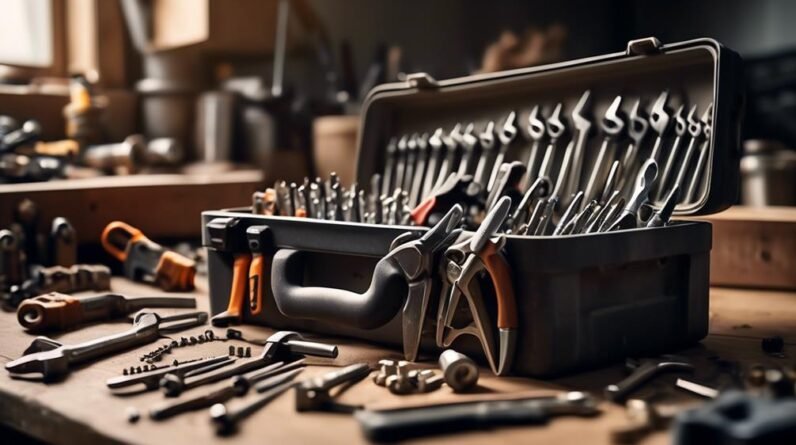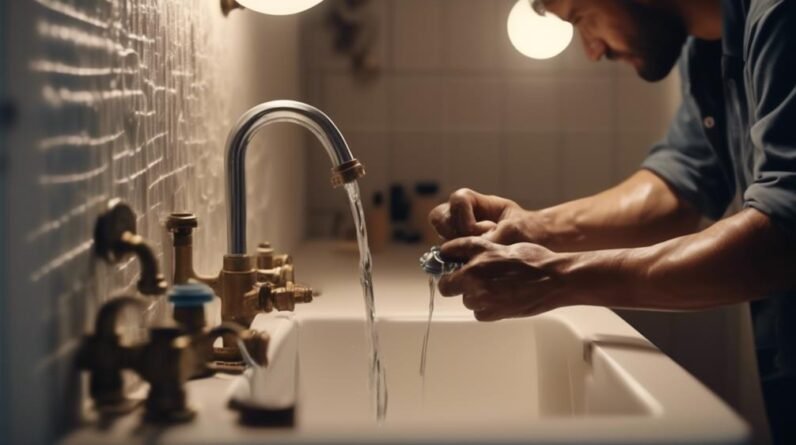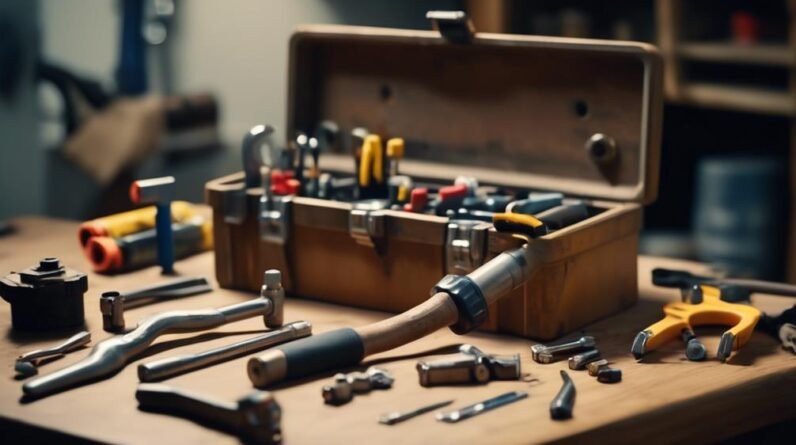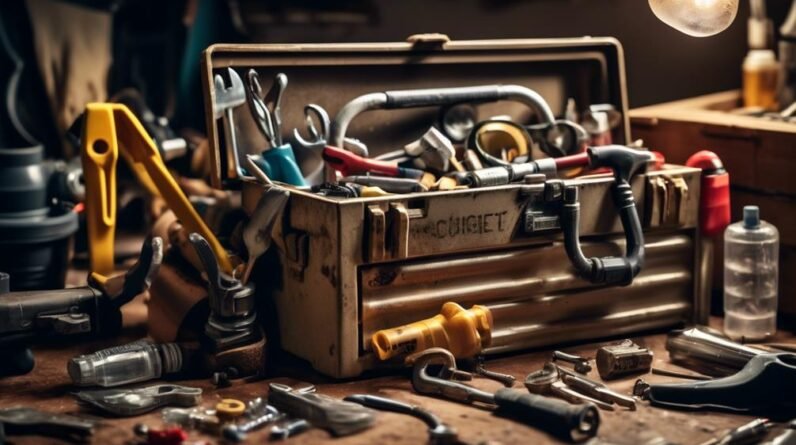
Imagine your home as a well-oiled machine, where every creak, leak, or stain is a cog that needs a little attention. Just like a seasoned mechanic, you don't need a fancy toolbox or years of experience to tackle these common household issues. With these 7 beginner-friendly hacks, you'll be armed with the knowledge to fix those pesky problems that can turn your cozy abode into a chaotic mess. So, grab your metaphorical wrench and let's get started on transforming your home into a smoothly running haven.
Key Takeaways
- Regular maintenance is important in preventing and fixing common home repairs like leaky faucets, squeaky doors, and clogged drains.
- Basic tools and materials like spackling compound, putty knife, vinegar, baking soda, and wire strippers are essential for DIY home repairs.
- Safety precautions should be taken when working on home repairs, such as turning off the power supply, using a sturdy ladder, and following instructions carefully.
- Home security measures, such as installing deadbolt locks, using security systems, and maintaining well-lit surroundings, are essential for protecting your home.
Fixing a Leaky Faucet
If you have a leaky faucet, fixing it is easier than you might think. Leaky faucets are not only annoying but can also waste a significant amount of water over time. The good news is that most faucet leaks can be fixed with a few simple steps.
One common cause of faucet leaks is a worn-out washer. Over time, the washer inside the faucet handle can become worn or damaged, causing water to leak out. To fix this, you'll need to turn off the water supply to the faucet, remove the handle, and replace the washer with a new one. It's a simple fix that can save you from a constant drip.
Another common cause of faucet leaks is a faulty O-ring. The O-ring is a small rubber ring that helps create a watertight seal inside the faucet. If the O-ring becomes worn or damaged, it can cause water to leak around the base of the faucet. To fix this, you'll need to turn off the water supply, remove the handle and spout, and replace the O-ring with a new one.
To prevent future leaks, it's important to avoid turning the faucet handle too tightly and to perform regular maintenance. Inspect the washer and O-ring for any signs of wear and tear, and replace them as needed. By following these simple steps, you can fix your leaky faucet and prevent future leaks.
Repairing a Squeaky Door
Is your door making an annoying squeaking sound every time you open or close it? Don't worry, there are a few simple steps you can take to fix it. First, try lubricating the door hinges with WD-40 or a silicone-based lubricant. If that doesn't work, check for any loose screws and tighten them. Lastly, consider using door stoppers to prevent the door from rubbing against the frame. With these easy hacks, you'll have your squeaky door silenced in no time.
Lubricating Door Hinges
To fix a squeaky door, start by lubricating the hinges. Here are some tips to help you effectively lubricate your door hinges:
- Choose the best lubricant: Use a silicone-based lubricant or a lubricating oil like WD-40 to lubricate your door hinges. These lubricants work well in reducing friction and eliminating squeaks.
- Remove dirt and debris: Before applying the lubricant, make sure to clean the hinges using a soft cloth or a brush. This will remove any dirt or debris that may be causing the squeaking.
- Apply the lubricant: Spray or apply a small amount of lubricant directly onto the hinge pins or into the hinge mechanism. Move the door back and forth to distribute the lubricant evenly.
- Repeat regularly: To prevent future squeaking, it's recommended to lubricate your door hinges at least once a year or whenever you notice any signs of squeaking.
Tightening Loose Screws
When addressing a squeaky door, the next step after lubricating the hinges is to tighten any loose screws. Loose screws can contribute to the squeaking sound and can also affect the door's stability. To tighten the screws, start by examining each screw in the hinges and the door handle. Use a screwdriver to tighten them clockwise until they're snug. Be careful not to overtighten, as this can strip the screws or damage the wood. If you encounter stripped screws, you can use alternative methods such as inserting toothpicks or wooden dowels into the holes before reinstalling the screws. This provides a better grip and helps secure the screws. Common mistakes include using the wrong size screwdriver or not checking all the screws thoroughly. By properly tightening loose screws, you can effectively fix a squeaky door and improve its functionality.
Using Door Stoppers
One simple and effective solution for repairing a squeaky door is to use door stoppers. Here are four creative alternatives to traditional door stoppers that can help prevent door damage:
- Rubber Bands: Wrap a thick rubber band around the doorknob and the door frame. This will create enough friction to keep the door from moving and prevent it from squeaking.
- Soap: Rub a bar of soap along the hinges and the area where the door meets the frame. The soap will act as a lubricant and reduce friction, eliminating the squeaky sound.
- Petroleum Jelly: Apply a small amount of petroleum jelly to the hinges. This will lubricate the moving parts and silence the squeak.
- Wax Paper: Cut a small square of wax paper and rub it on the hinges. The wax will provide lubrication and help eliminate the squeak.
Unclogging a Drain
Clear your clogged drain easily with these simple home hacks. Don't let a clogged drain ruin your day when you can easily fix it yourself. To prevent future clogs, there are a few things you can do. First, use a drain strainer to catch hair, soap residue, and other debris before they go down the drain. This simple tool can make a big difference in preventing clogs. Additionally, avoid pouring grease or oil down the drain, as they can solidify and cause blockages. Now, let's talk about DIY drain cleaners. One effective method is using a mixture of baking soda and vinegar. Start by pouring half a cup of baking soda down the drain, followed by half a cup of vinegar. Let it sit for about 30 minutes, then flush with hot water. Alternatively, you can use a combination of salt and hot water to unclog your drain. Simply pour a handful of salt down the drain, followed by boiling water. Repeat if necessary. These simple hacks will help you unclog your drain and keep it flowing smoothly.
Patching Small Holes in Walls
To patch small holes in walls, you will need a few materials such as spackling paste, a putty knife, sandpaper, and paint. The first step is to clean the hole and remove any loose debris. Then, apply a small amount of spackling paste with the putty knife, making sure to smooth it out. Once it's dry, sand the area until it's smooth and finally, paint over it to match the rest of the wall.
Materials Needed
You'll need a few essential materials to effectively patch small holes in walls. Here's what you'll need:
- Spackling compound: This creamy substance is perfect for filling in small holes and cracks in walls. It dries quickly and can be sanded down for a smooth finish.
- Putty knife: A putty knife is necessary for applying the spackling compound to the hole. Its flat, flexible blade allows for easy application and spreading.
- Sandpaper: After the spackling compound has dried, you'll need sandpaper to smooth out any rough edges. Use a fine-grit sandpaper for a seamless finish.
- Paint: Once the wall is smooth and the hole is filled, it's time to paint. Choose a paint color that matches your wall and apply it evenly over the patched area.
Step-By-Step Instructions
Looking to patch small holes in your walls? Here's a step-by-step guide to help you get started with beginner-friendly techniques:
- Gather Your Materials: You will need spackling paste, a putty knife, sandpaper, and a damp cloth.
- Prepare the Hole: Use the putty knife to remove any loose debris from the hole and clean the area with a damp cloth.
- Apply the Spackling Paste: Take a small amount of spackling paste on the putty knife and fill the hole. Smooth it out using the knife, making sure it is level with the wall surface.
- Sand and Finish: Once the paste is dry, sand it lightly with sandpaper until it is smooth. Wipe away any dust with a damp cloth.
Replacing a Light Fixture
If you're new to home improvement, replacing a light fixture is a simple and rewarding project that you can easily tackle. Whether you want to update the look of a room or fix a broken fixture, here are some tips to help you with your light fixture installation:
- Turn off the power: Before you start, make sure to turn off the power to the light fixture at the circuit breaker. This will prevent any accidents or electrical shocks.
- Follow the instructions: Each light fixture may have different installation instructions, so it's important to read and follow them carefully. This will ensure that you install the fixture correctly and safely.
- Check for common problems: Before replacing the fixture, check if the issue is with the light bulb or the wiring. Sometimes, a simple bulb replacement can fix the problem.
- Use the right tools: Make sure you have the necessary tools, such as a screwdriver and wire strippers, to remove the old fixture and install the new one. Using the right tools will make the job easier and safer.
Cleaning and Maintaining Gutters
To keep your gutters clean and functioning properly, regular maintenance is essential. Preventing gutter clogs is a crucial part of this maintenance. By keeping your gutters free from debris, you can prevent water from overflowing and causing damage to your home's foundation or landscaping. One way to do this is by using the right gutter cleaning tools. A gutter scoop or a small trowel can be used to remove leaves, twigs, and other debris from the gutter channels. Additionally, a high-pressure hose attachment can be used to flush out any remaining dirt or small particles. It is important to select tools that are sturdy and long enough to reach the gutters comfortably. Remember to work safely and use a sturdy ladder or a gutter cleaning system that allows you to clean the gutters from the ground. By regularly cleaning and maintaining your gutters, you can ensure that they continue to function properly and protect your home from water damage.
Removing Stubborn Stains From Carpets
For a quick and effective way to remove stubborn stains from carpets, try using a carpet stain remover. These products are specifically designed to tackle tough stains and can be found at most supermarkets or home improvement stores. Here are four carpet cleaning techniques that you can try at home:
- Blot the stain: Start by blotting the stain with a clean, white cloth or paper towel. Avoid rubbing the stain, as this can push it deeper into the carpet fibers.
- Use a homemade stain remover: Create your own stain remover by mixing equal parts white vinegar and water. Apply the mixture to the stain and let it sit for a few minutes. Blot the area with a cloth until the stain is lifted.
- Try club soda: Pour some club soda onto the stain and let it sit for a few minutes. Blot the area with a cloth to remove the stain. Club soda works well for removing common stains like coffee or red wine.
- Consider steam cleaning: If the stain persists, you may want to consider steam cleaning your carpets. This method uses hot water and a cleaning solution to penetrate deep into the carpet fibers and remove stubborn stains.
Frequently Asked Questions
How Do I Fix a Leaky Toilet?
To fix a leaky toilet, start by troubleshooting the issue. Check if the flapper is worn or damaged, and if it is, replace it. This beginner-friendly hack will help you stop toilet leaks.
What Should I Do if My Showerhead Is Leaking?
If your showerhead is leaking, try these beginner-friendly hacks. First, check for any loose connections and tighten them. If that doesn't work, you may need to replace the rubber washer or the entire showerhead.
Can I Use WD-40 to Fix a Squeaky Door?
Yes, you can use WD-40 to fix a squeaky door. It acts as a lubricating oil and can help reduce the friction causing the squeak. Alternatively, you can try using other lubricants like graphite or silicone spray.
How Do I Remove a Stubborn Clog From My Bathtub Drain?
To remove a stubborn clog from your bathtub drain, try using a plunger or a drain snake. Remember to practice regular bathtub drain maintenance by using a hair catcher to prevent future clogs.
What Is the Best Method to Repair a Large Hole in a Wall?
To repair a large hole in a wall, start by cleaning the area and removing any loose debris. Then, apply a patch made of drywall or mesh tape and joint compound. Sand it smooth and paint to match.
Conclusion
In conclusion, these beginner-friendly hacks provide practical solutions for common home repair issues. By following these simple steps, you can easily fix a leaky faucet, repair a squeaky door, unclog drains, patch small holes in walls, replace a light fixture, clean and maintain gutters, and remove stubborn stains from carpets. With these valuable tips, you can save time and money by tackling these repairs on your own.







